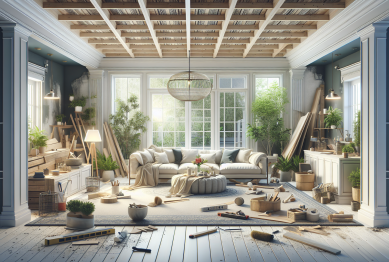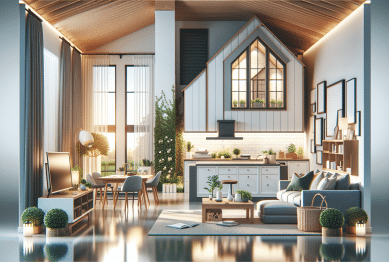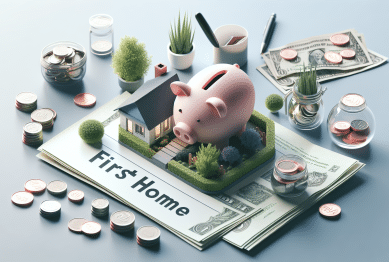Unlock fascinating ways to increase home value and make every improvement count. This guide explores renovation ideas, curb appeal, energy upgrades, and insider tips that help many homeowners see real returns on their investment.
Understanding Market Value Trends
Understanding shifting home market trends is essential for any property owner hoping to maximize returns. Local and national economic indicators, such as job growth, interest rates, and population shifts, play big roles in determining real estate value. Becoming familiar with these factors empowers homeowners to make informed choices about when to sell, when to renovate, or when to hold. Industry reports often reveal that modest upgrades can contribute noticeably to a property’s competitive edge in different markets, depending on what buyers are seeking at the moment. The keyphrase increase home value fits naturally here—because following trends helps prepare for impactful upgrades.
Timing matters. A renovation done just before a housing market upswing could result in a more favorable appraisal, especially if it aligns with preferred styles and amenities in demand. Market value also responds to external events like new developments, schools, or infrastructure changes nearby. Staying up to date through online resources or real estate seminars gives a clear sense of what improvements may yield better long-term value, making smart real estate investments accessible to more people. Every market is unique, so what adds substantial value in one area might do less in another—local research is key.
Consulting with a local real estate agent or appraiser provides fresh insights into current buyer preferences and emerging trends. This expertise is especially valuable when choosing between options like a kitchen remodel, bathroom upgrade, or additional bedroom. For instance, some neighborhoods see more growth with added outdoor spaces or modernized energy systems. These professional insights, backed by market data, can help property owners prioritize their investments and enhance their homes based on real-time value drivers in their area. It’s all about moving with the market, not blindly following every trend.
Low-Cost Upgrades That Offer Big Value
Homeowners often wonder if simple, low-cost upgrades can truly make a difference in resale value. The answer is yes. Even minor renovations, such as repainting walls in neutral colors or replacing outdated hardware, can create a much more inviting atmosphere. Real estate professionals say that first impressions are vital—fresh paint and sparkling fixtures help a space look well-maintained. These improvements invite potential buyers to imagine themselves in the home, boosting perceived property value without requiring a large investment. You don’t need a fortune to start seeing real change.
Curb appeal is another area where small touches make a sizable impact. Tidying up the garden, planting colorful flowers, and fixing cracked walkways can elevate the visual appeal of a home almost overnight. Industry studies indicate that homes with thoughtful landscaping and clean exterior details sell faster and at higher prices than similar properties with neglected yards. The exterior is the first thing people see, and it sets the tone for what to expect inside. This is why outdoor lighting and house number updates are also effective, budget-friendly options.
Updating lighting inside the home can also offer notable returns. Swapping dated fixtures for modern LED solutions enhances both energy efficiency and ambiance. Potential buyers often appreciate move-in-ready environments where they won’t need to budget for immediate repairs or aesthetic fixes. The combined result of these small steps is a more marketable property, often noticed during open houses or online listings. For many, these approachable upgrades represent the first move toward a larger renovation plan, making them both practical and profitable.
Renovations That Attract Buyers Most
Not all renovations are created equal when it comes to boosting resale potential. Kitchen remodels consistently rank at the top of buyer wish lists, particularly when updated appliances and efficient layouts are involved. A modern kitchen often signals that the rest of the property is similarly maintained and updated. Bathroom upgrades closely follow—simple changes like new vanities, fixtures, or water-efficient toilets can transform an outdated space into a highlight of the home. These renovations provide functional and visual improvements that cater to lifestyle needs often voiced by potential buyers.
Experts point out that adding usable space, like a finished basement or an additional room, increases living area, which typically appeals to larger households or those looking for flexible work-at-home options. As flexible spaces become more relevant, properties with offices, gyms, or extra bedrooms stand out from the competition. This approach is particularly valuable in markets where square footage is at a premium and can be the deciding factor for families or remote workers who need adaptability in their living environment. Smart floorplan changes can also modernize older homes.
Don’t overlook energy-efficient renovations. Solar panels, better insulation, and smart thermostats have become selling points for many eco-conscious buyers. Homes with green features often command premium prices and attract quicker interest because they offer long-term utility savings. Such improvements reduce operating costs while appealing to a growing segment of environmentally aware consumers. In many regions, energy upgrades are even incentivized through local programs, making these improvements an attractive investment for homeowners considering future resale or better day-to-day comfort.
Strategies for Effective Curb Appeal
Curb appeal is more than just a real estate buzzword—it’s a practical tool that can change a home’s market prospects overnight. Studies reveal that buyers form opinions within seconds of seeing a property. A tidy lawn, colorful planters, and power-washed siding emphasize pride of ownership and signal that the interior is also likely to be well cared for. These affordable, quick fixes can increase home value even before a viewing begins. Little changes make big impressions.
Sustainable landscaping is a growing trend. Using drought-resistant plants and smart irrigation systems not only maintains visual flair but also lowers maintenance and water bills. This appeals especially to modern buyers prioritizing environmental responsibility and long-term value. Outdoor features like a cozy seating area, fire pit, or updated walkway lighting can create inviting spaces that expand usable living area and support lifestyles focused on relaxation and entertaining. First impressions matter—and curb appeal continues to have a ripple effect throughout the sale process.
Don’t underestimate the power of a welcoming entryway. Repainting the front door, updating hardware, and ensuring the path is clean and accessible enhance the sense of arrival. Seasonal decorations or personalized touches, like a new doormat, add charm without overwhelming visitors. Combined, these strategies help a property stand out in crowded listings and encourage greater interest from prospective purchasers, making the first step past the threshold a memorable one. Curb appeal drives curiosity—and offers tangible returns at closing time.
Energy Efficiency and Smart Home Upgrades
Today’s homebuyers increasingly seek energy-efficient features and smart technologies that promise future savings and daily convenience. Upgrading to double- or triple-pane windows, adding attic insulation, or investing in high-efficiency HVAC systems can all reduce energy bills while creating more comfortable living environments. Builders and real estate specialists note that homes carrying ENERGY STAR certifications or similar eco-labels often attract motivated buyers willing to pay a premium for reduced operating costs and the peace of mind that comes with modern efficiencies.
Smart home technologies are another area of growth. Devices like programmable thermostats, security cameras, and lighting systems controlled by smartphone apps give properties a modern edge and practical advantages. These systems improve daily life by offering remote management and increased safety, which appeals to both tech enthusiasts and those new to digital upgrades. New buyers value the combination of ease and control that smart homes deliver, and as these technologies become more affordable, their role in property marketing grows stronger each year.
The integration of energy efficiency and technology investments can also help with future-proofing a home. By anticipating regulatory changes and evolving buyer expectations, property owners who pursue these upgrades position themselves ahead of the curve. Many utility providers and local governments offer rebates or tax incentives to support energy-smart remodeling. Navigating these opportunities often pays off through immediate utility savings and future increases in property value, aligning financial and environmental gains under one roof.
Staging and Presentation Secrets
Staging a home is about telling a story. Professional stagers and REALTORS agree that tasteful arrangement and decluttering help buyers envision themselves living in the space, which increases perceived value. Simple touches—a bowl of fresh fruit, neatly folded towels, or strategically placed mirrors—invite light and create warmth. Removing personal mementoes or large collections makes rooms feel open and inviting. Savvy homeowners regularly find that staged homes outperform non-staged ones both in online photos and in-person visits.
Smell and sound matter, too. Clean air and subtle, pleasant fragrances suggest a home has been cared for. Playing soft background music during showings or virtual tours can help relax visitors and create positive associations. These subtle cues influence subconscious buying decisions. Consistent cleanliness and minor repairs—like fixing dripping faucets or squeaky doors—signal that the property has been meticulously maintained and is ready for new occupants. Presentation is never just about how things look; it’s about the experience they create.
Seasonal updates and adaptability are also important. In cooler months, cozy throws and soft lighting add comfort, while in spring and summer, fresh flowers or open windows bring in air and life. The stage should adapt to current trends but never feel forced. The result? Homes that linger in a buyer’s mind. Even small investments in presentation—neutral palettes, organized closets, or professionally steamed carpets—offer measurable returns, often resulting in faster sales and higher offers than similar, less polished properties.
References
1. National Association of Realtors. (n.d.). Remodeling Impact Report. Retrieved from https://www.nar.realtor/research-and-statistics/research-reports/remodeling-impact
2. U.S. Department of Energy. (n.d.). Energy Saver Guide: Tips on Saving Money and Energy at Home. Retrieved from https://www.energy.gov/energysaver/energy-saver-guide
3. Federal Housing Finance Agency. (n.d.). House Price Index. Retrieved from https://www.fhfa.gov/DataTools/Downloads/Pages/House-Price-Index.aspx
4. U.S. Environmental Protection Agency. (n.d.). ENERGY STAR for Homes. Retrieved from https://www.energystar.gov/newhomes
5. American Society of Landscape Architects. (n.d.). Residential Landscape Architecture Trends Survey. Retrieved from https://www.asla.org/landscapearchitecturetrends.aspx
6. Zillow. (n.d.). What is Home Staging? Retrieved from https://www.zillow.com/sellers-guide/what-is-home-staging/









